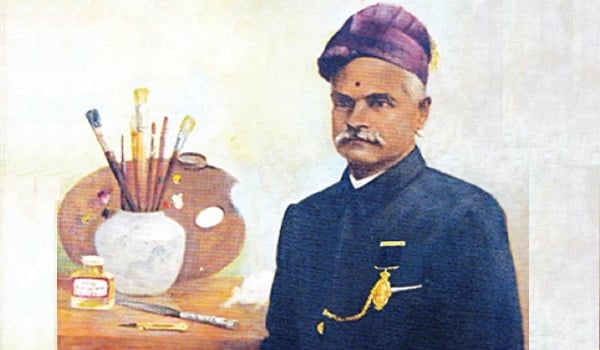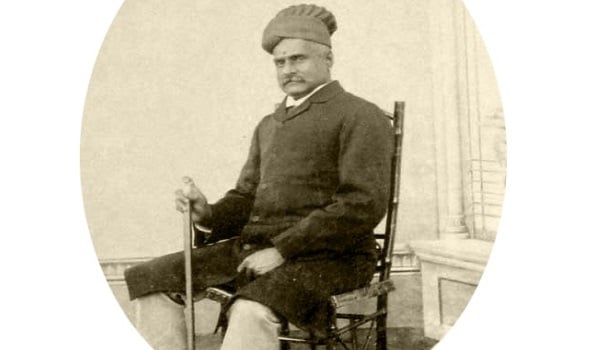Fact Sheet
Date of Birth: April 29, 1848
Place of Birth: Kilimanoor, Travancore
Date of Death: October 2, 1906
Place of Death: Attingal, Travancore
Profession: Painter, artist
Spouse: Pooruruttati Nal Bhageerathi Bayi Thampuratty
Children: Kerala Varma, Cheria Kochamma, Uma Amma, Mahaprabha Amma, Rama Varma
Father: Ezhumavil Neelakanthan Bhattatiripad
Mother: Umayamba Bayi Thampuratty
Awards: Kaisar-i-Hind Gold Medal (1904)
Raja Ravi Varma was an Indian painter and artist, considered as one of the greatest painters in the history of Indian art. Raja Ravi Varma is known for his amazing paintings, which revolve mainly around the Puranas (ancient mythological stories) and thegreat Indian epics - Mahabharata and Ramayana. Ravi Varma is one of the few painters who managed to accomplish a beautiful union of Indian traditionwith the techniques of European academic art. This is one of the reasons why he is considered as one of the most, if not the most prominent Indian painters. Varma was also responsible in taking the Indian art all over the world with his impeccable technique. While the Europeans and other art lovers admired his technique, the laymen of India enjoyed his work for its simplicity. More often than not, Varma’s paintings highlighted the beauty of South Indian women which were admired by all. His portrayal of Hindu gods and goddesses went on to become worship material for many people belonging to the lower castes. Back then, these people were often forbidden from entering temples and thus they celebrated Varma's works, for they gave them an idea of how the deities looked inside the temple. He also managed to improve the artistic knowledge and spread the importance of art among Indian people. He achieved this by making affordable lithographs, which were accessible even to the poor. Alternatively, this also made him a household name and Raja Ravi Varma soon captured the hearts of all. Recognizing his feat, Viceroy Lord Curzon honored him with the Kaisar-i-Hind Gold Medal for his service in thefurtherance of public interest.

Childhood and Early Life
Raja Ravi Varma was born to Neelakanthan Bhattatiripadand Umayamba Thampuratty in the royal palace of Kilimanoor. He grew up along with three siblings (two brothers and a sister). Out of his siblings, Raja Varma, his younger brother, would later join him and assist him in his works throughout his career. The inborn talent of the painter started showing at a very tender age. Recognizing the innate aptitude of their child, his parents sent him to study under the patronage of Ayilyam Thirunal Maharaja of Travancore, when he was only 14 years old. He received tutelage, first from the palace painter Rama Swami Naidu, who taught him the nuances of water painting and then from Theodor Jenson, a Dutch painter, who gave him lessons on oil painting.
Career
Raja Ravi Varma started his career at a young age and soon enjoyed widespread recognition for his works. In 1873, his paintings were not only exhibited at a prominent exhibition in Vienna, but he also won an award for one of his displays. He then bagged three gold medals for his work, when they were sent to Chicago to be displayed at the prestigious World's Columbian Exposition held in the year 1893. It is only fair to say that British administrator Edgar Thurston was largely responsible for taking Varma’s paintings overseas. But once the paintings reached the foreign shores, they spoke for themselves. Such was his brilliance. Throughout his career, Varma travelled all over India, hoping to find the right subjects for his art. He showed special interest in portraying the charm of South Indian women. He even often depicted his close kin and made them popular through his art. Some of them included Varma's daughter Mahaprabha, who was depicted as carrying one of her sons and his sister-in-law Bharani Thirunal Lakshmi Bayi, who would later adopt his granddaughters.
His paintings can be classified into three categories – portraits, portrait-based compositions and theatrical compositions based on myths and legends. It is the third category of paintings for which Raja Ravi Varma is most renowned.Through his paintings, he gave an insight of the famous mythological stories to those who were not fortunate enough to hear or read them. The most popular as well as the most impressive paintings of Raja Ravi Varma that falls under this category include the ones depicting episodes from the story of Dushyanta and Shakuntala and that of Nala and Damayanti.The ones from the Hindu epic Ramayana include Lord Rama’s triumph over Varuna and Ravana’s expression of arrogance while clipping one of the wings of Jatayu. Also,in many of his paintings, he has modeled Hindu Goddesses on the women living in the southern parts of India, for which he was criticized on various accounts.

Varma's Lithographic Printing Press
Around Ravi Varma’s time, lithographic printing was gaining popularity in many European countries and in the United States. Based on its worldwide acceptance, the then Dewan of Travancore, T. Madhava Rao suggested Varma and his brother to come up with a press of their own. Intrigued by this new idea, Ravi Varma first started a press in Mumbai and later shifted it to a place near Lonavala. The press came up with tons of oleographs, depicting Hindu gods and goddesses. Back then, the press was the largest and most advanced in the whole of India. Post the demise of the great painter, the press was managed by his brother. But unfortunately, it soon ran into financial troubles and was eventually sold to Fritz Schleicher, a German technician who was part of the press from the very beginning. Fritz Schleicher managed to turn the tide by employing less talented artists and through commercialization of the press by accepting offers from advertising labels. However, in 1972, the entire unit was burnt to ashes as a devastating fire gobbled up the entire factory and with it some of the most fascinating original lithographic prints of Raja Ravi Varma.
Great Paintings of Raja Ravi Varma
Raja Ravi Varma produced many masterpieces of art during his life. Here is a comprehensive list of some of the most prominent works of Raja Ravi Varma:
- A Family of Beggars – This painting represented the sorry state of Indian economics.
- A Lady Playing Swarbat – Just like many of his paintings, this too, was modelled after a South Indian woman.

Image Source: Wikipedia.org
- Arjuna and Subhadra – This painting narrates a story from the Hindu epic Mahabharata.
- Damayanti Talking to a Swan – This too is a scene straight out of Mahabharata.
- Draupadi Dreading to meet Kichaka – Once again, this picture narrates a story from Mahabharata.
- Girl in Sage Kanwa's Hermitage (Rishi-Kanya) – This story talks about the story of Shakuntala.
- Jatayu (a bird devotee of Lord Rama) – This is perhaps one of the most commonly featured work of Raja Ravi Varma. The picture narrates the story of Jatayu who gives up its life after fighting the mighty villain Ravana from Ramayanam.

Image Source: Wikipedia.org
- Lady Giving Alms at the Temple – This is a common sight even in the present day India.
- Lady Lost in Thought – Once again this painting was modelled after a South Indian woman.

Image Source: engrave.in
- Lady with Fruit – Probably modelled after Ravi Varma’s mistress, this painting gives you an impression that it was one of Varma’s personal favorite.
- Lord Krishna as Ambassador – This is one of those painting that depicted a Hindu deity.
- Lord Rama Conquers Varuna – After ‘Jatayu’ this is probably the most famous among the ones that narrates the story of Ramayanam.
- Nair Woman – As the name suggests, this painting portrays a Malayali woman in all her glory.

Image Source: Wikipedia.org
- Romancing Couple – This painting goes on to show that Raja Ravi Varma was not a painter who limited himself to depicting only gods and goddesses.
- Shakuntala – This painting depicts the legendary woman Shakuntala who marries Dushyanta. The couple later gave birth to Bharata after whom ancient India was named.
- Shakuntala Composing a Love Letter to King Dushyanta – This depicts the love story of Shakuntala and King Dushyanta.

Image Source: 121clicks.com
- Shantanu and Matsyagandha – This story from Mahabharata depicts the interaction between Shantanu and Matsyagandha.

Image Source: Wikipedia.org
- The Heartbroken – This painting depicts a South Indian woman who looks extremely disappointed.
- The Orchestra – This depicts a band of musicians from South India.
- Victory of Maghanada (Indrajit) – This painting depicts the triumph of Lanka prince Indrajit over Indra Loka. The story is mentioned in the Indian epic Ramayana.

Image Source: Wikipedia.org
Criticism
Raja Ravi Varma is often criticized for being too showy in his paintings. His paintings are also condemned for overshadowing traditional Indian art forms, especially the ones depicting Hindu gods and goddesses. Raja Ravi Varma's approach is said to lack the dynamism of expression seen in the traditional paintings. Critics have also criticized him for modelling goddesses after prostitutes, saying that his representation of deities have reduced them to the level of mortals. He was also fiercely criticized for depicting Indian women, especially women from Hindu mythologies with pale skin. It was always the lower class women who took the honor of flaunting dark skin in his paintings.

Image Source: https://www.1st-art-gallery.com
Recognition
In recognition of the immense contribution of Raja Ravi Varma towards Indian art, the Government of Kerala has instituted an award in his name. Known as the 'Raja Ravi Varma Puraskaram', the award is given to individuals who show considerable promise in the field of art and culture. There is a college in Mavelikkara district of Kerala, established in the honor of Raja Ravi Varma. He also received international recognition in 1873, when he won the first prize for his paintings at the Vienna Art Exhibition.
Personal Life
At the age of 18, Raja Ravi Varma married Rani Bhageerathi Bayi (Kochu Panki Amma), a 12 year old girl of Mavelikkara Royal House. He fathered five children, of whom the youngest son Rama Varma went on to become an artist after studying at the JJ School of Arts, Mumbai. Ravi Varma spent the later years of his life in Mysore, Baroda and a number of other cities in the country. This exposure helped him in broadening his outlook. At the same time, he was able to expand as well as sharpen his skills and evolve into a more prolific painter.
Legacy
Many movies have been made and novels written on the ostentatious life of Raja Ravi Varma. Out of those, Bollywood film ‘Rang Rasiya’ and Malayalam movie ‘Makaramanju’ are the most popular ones. Based on the novel ‘Raja Ravi Varma’, written by Ranjit Desai, the Maharashtra State Board included a chapter titled 'A Meeting Like Never Before' in one of its Marathi textbooks. The chapter was based on Ravi Varma’s meeting with Swami Vivekananda.



